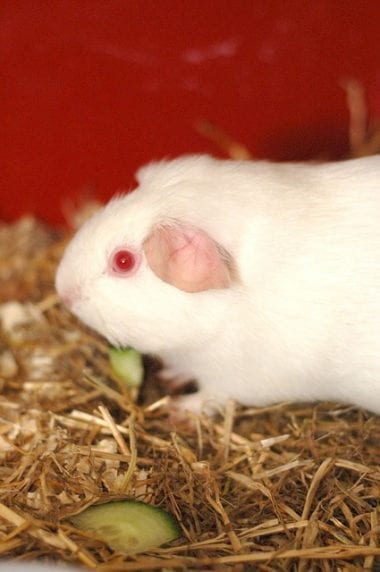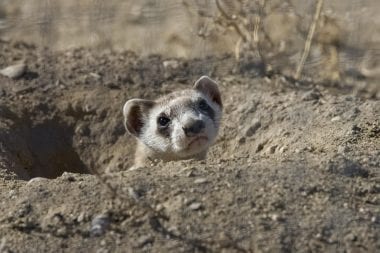Weasel is the term used to call several carnivorous mammals belonging to the genus Mustela of the Mustelidae family. The weasel with over 260 species in the order Carnivora is subdivided into two groups, Caniformia & Feliformia. The Caniformia denotes species with a dog-like appearance while the Feloformia species has a cat-like appearance. Weasel family or the Mustelidae family belongs to Caniformia with over 55 species of various mammals ranging from weasels, badgers, martens & otters, the largest in the Carnivora order.
The weasel has a characteristic look consisting of a lengthy slim body with a long neck, round ears, short legs along with tails varying in length. Weasels, belonging to the Mustelidae family, are generally found in various sizes & differ in behavior too. The smallest weasel is sizeably similar to a mouse and the largest being the giant otter weighing around 76 lb or 34 Kgs.
Weasels are small carnivorous mammals & known to be clever & cunning. In earlier times the weasel was considered as vermin as some species used to attack poultry or rabbit farms for food. Their lengthy thin body helps them to borough while catching prey in the field. They devour on rodent population especially rats, mice, shrews, & even squirrels and rabbits, which help aid the eco-system. Some weasels have thick, exquisite furs & have been valued for centuries in the fur trade. Weasels especially the mink, the ermine & the sable are bred & grown for their valuable Fur. As of now, it looks to be that the ferret is the only weasel to be domesticated as a pet.
Facts on the Weasel:
Origin:
- The term weasel was initially used only in referring to only one species, the Mustela nivalis of the Mustelidae family.
- Ferrets, minks, martens, otters, badgers polecats, tayras, wolverines, etc. are all related & belong to the genus Mustela of the Mustelidae family.
- Weasels are versatile in nature & live all over the world. While North America has the long-tailed weasel, the tropical weasel inhabits South America. In Japan, the weasels are found almost everywhere including the suburbs, forests & villages. The African region has the striped weasel whereas central & east Asia houses the mountain weasel.
- The short-tailed weasels are the most common and found in Asia, Europe & North America including the Arctic. The Weasel usually is at home in riverbank habitats, scrubs, alpine meadows, woodlands & marshes, etc.
Way of Life:
- Everyday Weasels eat more than 50% of their body weight & have excellent digestive power.
- Weasels have to consume food regularly as they have less body fat in their body.
- Weasels are fast & dig their own borrows quickly.
- Weasels devour rabbits, rats, lizards, hares, rodents, squirrels, frogs, dead meat, insect, etc. to name a few.
- Their small bodies have a great advantage while hunting or being hunted since they can squeeze into spots hard to reach or in getting in.
- Weasels hunt ferociously & are known to store surplus food below the ground near their dwelling borrows.
- Weasels intimidate their prey by jumping around back & forth, a tactic meant to confuse the animal before proceeding to kill it.
- In cold weather, the weasels lower their metabolic rate & curl up into a ball to keep warm.
- Any movement is recognized by the weasel as a prey triggering a ferocious hunt. It can hut & kill animals 10 times bigger than them.
- True to their nature weasels do not remain idle & keeps on hunting & storing food, depending on the availability of prey.
Growth Facts:
- Each species of weasels has different mating & birth patterns.
- Sexual maturity of a female weasel is attained when they are 3 months old.
- Weasels usually mate during summer or spring.
- At a given time a pregnant weasel can deliver between 8 and 15 babies, often called a litter.
- The firstborn weasels initially are blind to sight.
- The pregnancy period of weasels varies from 35 days to 10 months, depending on the species.
- Weasels live up to 10 years when confined & around 3 years in the wild but their lifespan averages between 1 and 2 years only.
Weasel Species:
- Weasel is the smallest carnivorous animal with the smallest among them measuring lengthwise 4 to 10 inches only & weighing just 1 ounce.
- Growth wise weasels can go up to 12 inches.
- The most common weasel is the short-tailed weasel & is found in European regions, South America, North America & Asia.
- The Mustela frenata or the long-tailed weasel is native to North America.
- The Mustela Africana or the tropical weasel, usually found in the Amazon, inhabits South America.
There are various other weasels from various regions such as:
- Mountain Weasel (Mustela Altaica) – Found in the Asian region.
- Colombian Weasel (Mustela Feipei) – Found in Colombia.
- Japanese Weasel (Mustela itatsi) – Found in Japan.
- Yellow-bellied Weasel (Mustela kathiah) – Found in the Asian region.
- Indonesian Mountain Weasel (Mustela lutereolina) – Found in Indonesia.
- Malayan Weasel (Mustela nudipes) – Found in Malaysia & Thailand.
- Siberian Weasel (Mustela sibirica) – Found in Asian region.
- Back-stripped Weasel (Mustela strigidorsa) – Found in Asian region.
- Egyptian Weasel (Mustela subpalmata) – Found in Egypt.
Decoding THE MALAYAN WEASEL (MUSTELA NUDIPES):

The Malayan Weasel like the other species of the Mustelidae family is found all over the Sundaic regions of Indonesia, Thailand, Malaysia, & Brunei. The Malayan Weasel falls under the least concern category (LC) by the IUCNs Red List of threatened species.
The Malayan Weasels usually are pale-headed with a strikingly golden-colored body & a unique tail setting it apart from other weasels. These species are quite elongated, the length ranging from 30 to 36 cm, even the tail varying in length from 24 to 26cm & weighing around 1 Kg.
Research wise nothing much is known about the Malay Weasel except it’s an untamed fast hunting species known to hunt down fast-moving prey skilfully. It can easily hunt down ground-dwelling prey since it can easily descend into borrows of the prey due to their smooth elongated body shape.
Various habitats such as plantations, grassland, swamp forest, scrub, or even primary & secondary forest are home to the Malayan Weasel.
Geography of the Malayan Weasel:
Historically these weasels belonged to the Malaysia-Thailand, Borneo & Sumatra region. Today it has extended geographically beyond Thailand, Malaysia, Indonesia & Brunei.
Similar to other species of weasels, the Malayan Weasels prefer staying in forested surroundings or deforested habitats in urban surroundings.
In the Mustela species, the male Malayan Weasel or the Mustela Nudipes are bodily longer than their females counterparts. Their fur color ranges from a hazy brown to a dirty white with a uniquely tipped yellow-white tail & a light-colored attractive head.
Research on Malayan weasels is yet to be undertaken but some studies have shown that they usually mate with more than one female Malayan weasel.
Studies have also shown that the female Malayan weasels sometimes can produce four litters in each breeding season. The female species of the Malayan Weasel are self-dependent & take care of their young ones solitarily.
The life-span of the Malayan Weasel is yet to be verified through research or studies. But it is estimated that their life span is similar to other similar-sized Mustelids & are expected to have a life span of 3 to 10 years.
The Character of the Malayan Weasel:
- Behavior: Even though sometimes seen in pairs, the Malayan Weasels are often considered as shy & solitary species. Despite its unearthly looks, many have observed the Malayan weasel swimming. They have a subtle way of movement & favorably prefer running in a silent zig-zagging pattern. Searching for food means checking on the surrounding grounds & hopping into logs for a mouthful.
- Communicating Patterns: Even though not researched the communication patterns of Malayan Weasels look quite similar to other weasels. Vocal sounds created during mating seasons along with warning signals including squeals, trills & even purrs, etc. are quite similar to the forms of communication among other weasels. The musk glands of the weasels are used by them in marking territories or hunting areas. The Malayan weasel usually communicates through scent, sound & other possible forms of action in warning others & even while mating.
- Food: The carnivorous Malayan Weasels hunt & search for food on logs, borrows & holes. They tend to gorge on numerous small rodents, along with lizards, insects & occasionally small birds. Some studies have documented that the Pythons are the hunters of the Malayan Weasels even though sometimes humans too have hunted them for food. Malayan Weasels hunts & controls the rodent population in rural areas.
- Feeding Facts: The Metabolic rates of the Malayan Weasel are extremely high & are devoid of body fats. They are required to eat every 60-90 minutes & in every 2 hours, for infants. Take care not to over-feed the weasel when feeding, especially a baby. Be careful while feeding new-born weasels as they start gorging on solid foods as their teeth appear long before their weaning & eyes opening up.
Different Beliefs about Sighting a Weasel:
The Greeks believe that sighting a Weasel near one’s house is bad luck.
The Japanese consider the cry of a Weasel as the cry of a ghost (“yokhai”) or a bad omen.
The Weasels are often considered as clever, magical, or mysterious spirits by Native Americans.
Germans find the Weasel magical while the people of Macedonia in the Balkans find them good fortune.
The Malayan Weasels are not extinct species & well protected in Thailand, Malaysia & surrounding regions. But the worrying point is that its population is slowly diminishing due to hunting.


